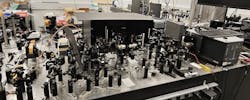Photonic topological quantum insulator makes quantum research more accessible
A team of RPI researchers led by Wei Bao, an assistant professor of materials science and engineering, built a photonic topological insulator. Topological insulators are intriguing for quantum work because they possess the highly desirable and exotic property of insulating in bulk while conducting along their edges.
The team’s photonic topological quantum insulator is designed to prevent photons from scattering throughout the material—and makes them coherently behave like a single photon (see video).
“Topological insulators can protect the unimpeded flow of electrons along the edges without dissipation and backscattering by many impurities and disorders,” explains Bao. “This visionary concept has been adopted for many systems, including photonics, where people hope to study topological physics and even protect photons from backscattering.”
What inspired this work?
Topological insulators exhibit many exotic quantum properties, and exciton polaritons—hybrid quasiparticles of excitons and photons within the same coupling regime—have been theoretically proposed for nearly 10 years as a tunable composition nonlinear platform for emulating topological phenomena.
“But the most striking feature of topological insulators is that their topological propagating modes are robust against sharp-turn corners or defects—which remains elusive within the polariton condensation regime, where each condensate can exhibit quantum coherence and interactions akin to cold-atom Bose-Einstein condensations (BECs),” Bao says.
It seriously limits research for constructing close analogs of topological condensed matter systems with polariton lattices. This, along with the excitement his colleagues around the world share on the topic, inspired Bao and his team to start thinking about how to take on this challenge during the summer of 2022.
Design work/setup
Bao’s team came up with a way to prepare large-scale room-temperature exciton polariton halide perovskites (CsPbCl3) to achieve room-temperature XY spin Hamiltonian lattices and superfluidity. Note: There’s only a tiny amount of lead (Pb) involved, and it’s used to make a stable octahedron cage in the perovskite structure.
What does the team’s work enable? “This foundation allows us to construct polariton topological insulators by nanofabrication patterning on our samples and achieve BEC of valley Hall topological boundary states through optical pumping,” Bao says. “Now, researchers can study quantum phenomena at room temperature with tunable light and matter composition quasiparticles called ‘polaritons.’”
Exciton polaritons directly affect the interaction between particles by “regulating the hybrid composition of light and matter,” Bao says. “And the system’s wave function can be adjusted by applying an external periodic potential or electric field or magnetic field, which provides an easy-to-control nonlinear multibody system for emulation.”
The ability to construct topologically protected propagating edge states within a photonic quantum fluid BEC is a major leap forward for the field—with applications ranging from structure design to material systems to experimental methods.
To do it, they grow ultrathin plates of halide perovskite, which consists of cesium, lead, and chlorine, and then etch a polymer atop it. The perovskite plates and polymer get sandwiched between sheets of various oxide materials and end up a tiny ~2 μm thick and 100 μm in length and width.
Combining a negative feedback method with a spatial light modulator allows the researchers to control the excitation light shape in real time and create uniform polariton condensation on irregular topological boundaries.
When the researchers shine laser light onto the device, a glowing triangular pattern appears at the interfaces designed in the material and it’s caused by the topological characteristic of lasers.
“We clearly demonstrated topological protected edge states at room temperature—without an external magnetic field,” Bao says. “And we clearly observed long-range spatial coherence of the quantum fluid.”
Surprises/challenges along the way
Bao’s team experienced two “a-ha!” moments. First, they discovered a large topological bandgap within the microcavity, and then they observed uniform polariton condensation along the entire topological edge. “Our data surprised us—it was such a good feeling, like receiving a gift I wanted as a kid,” he says.
Biggest challenge involved? “Design and measurement of the experiment,” says Bao. “I’m happy my students achieved this breakthrough—and in a short time, thanks to their efforts.”
Beyond providing a room-temperature polariton platform to simulate topological physical phenomena, the researchers’ work can be used to build large-scale coherent topological laser arrays.
“We’re now working to extend our studies to chiral perovskite or 2D materials for helical polaritons or other exciting topological designs, such as quantum spin Hall insulators, to manipulate the spin and chiral propagating topological condensations,” says Bao.
About the Author
Sally Cole Johnson
Editor in Chief
Sally Cole Johnson, Laser Focus World’s editor in chief, is a science and technology journalist who specializes in physics and semiconductors.


